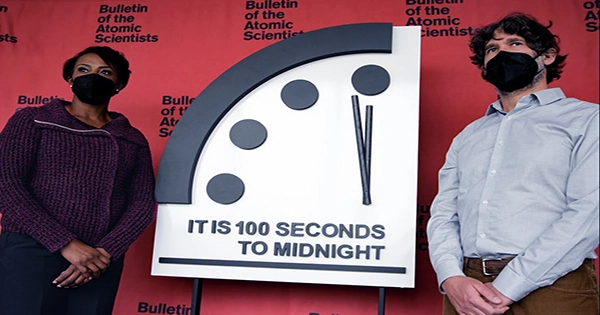The Doomsday Clock will remain at 100 seconds to midnight in 2022, according to the Bulletin of the Atomic Scientists. The closer we go to midnight – sometimes known as “doomsday” – the closer humanity comes to disaster. The clock has been stuck at 100 seconds to midnight for the last two years, the closest it has been to midnight since it was constructed in 1947. Its purpose is to emphasize that we are still in a critical historical period, and humanity is closer than ever to a probable apocalypse. The position of the clock is determined by attempting to answer two questions: humankind safer this year than it was last year, and is humanity safer from human-made threats during the last 75 years?
The board emphasizes that advances have been made, but not enough to turn back the clock. From increased nuclear weapons stockpiles to the US insurgency on January 6, 2020, climate change action and inaction, and the pandemic and misinformation around it, 2021 had a lot to offer.
“In 2021, there were some encouraging developments in each of the Science & Security Board’s areas of concern.”However, these have not been able to counter the longer-term unfavorable trends that continue to degrade security,” Sharon Squassoni, co-chair of the Bulletin of the Atomic Scientist’s Science and Security Board, said at the news conference. In 1947, the clock designed. With the advent of atomic weapons at the start of the Cold War, it became evident that governments had the capability to wipe out humanity by pressing a few buttons in the US or the USSR. The clock was set to 7 minutes to midnight at the time.
After seventy-five years, the clock continues to tick over nuclear weapons stockpiles, which are now present in many more countries, as well as other threats. The climate problem, as well as the lack of real action by the world’s largest greenhouse gas emitters, is unquestionably a critical moment. There is also an increase in the usage of disruptive technology, as well as a lack of regulation, which contributes to online misinformation, cyberwarfare, and artificial intelligence. The time was set to 11:43 p.m. in 1991, as tensions between the former Soviet Union and the United States lessened following Germany’s reunification and the signing of the first Strategic Arms Reduction Treaty.
However, the possibility of nuclear war remains; there are over 13,000 nuclear bombs on the planet, which could potentially kill millions of people in a matter of hours if a nuclear war broke out. Last year, we focused on the response to the COVID-19 pandemic and it demonstrated that humanity is still unable to tackle challenges that can drastically disrupt our way of life. The outlook is dismal, given the hurdles ahead.
















